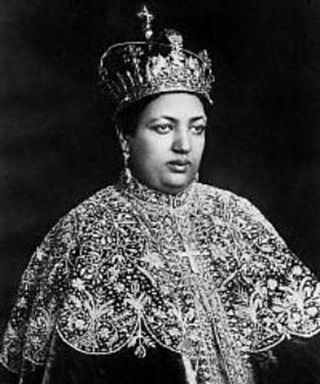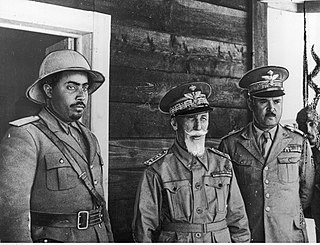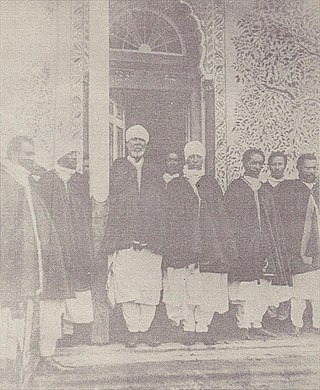
Menen Asfaw was Empress of Ethiopia as the wife of Emperor Haile Selassie.
Princess Romanework Haile Selassie, sometimes spelt as Romane Work Haile Selassie, was the eldest child of Emperor Haile Selassie of Ethiopia by his first wife, Woizero Altayech.

Olol Dinle was a Somali sultan who ruled Kelafo as the head of the Ajuran. He successively offered allegiance to the Kingdom of Italy in the 1920s and was named "Sultan of Sciavelli (Shabelle) and Auia (Hawiye)" in the early 1930s.

RasDesta Damtew KBE was an Ethiopian noble, army commander and a son-in-law of Emperor Haile Selassie I. He is known for his leadership in the Ethiopian Army during the Second Italo-Ethiopian War. He was executed on 24 February 1937, by the Italian Armed Forces shortly after Ethiopia's loss in the war.

Ethiopian forces in the Second Italo-Abyssinian War besides the Central Army were mobilized from various provinces under their local leader. According to 1935 Italian intelligence estimates of the Ethiopian provinces and their forces on the eve of hostilities, the Ethiopians had an army of 350,000 men. Strengths where known are noted followed by their leader. Modernized forces in Bold.

Leul Ras Imru Haile Selassie, CBE was an Ethiopian noble, soldier, and diplomat. He served as acting Prime Minister for three days in 1960 during a coup d'état and assassination of Prime Minister Abebe Aregai.

DejazmachBalcha Safo, popularly referred to by his horse-name Abba Nefso, was an Ethiopian military commander and lord protector of the crown, who served in both the First and Second Italo-Ethiopian Wars.

The Battle of Ganale Doria took place in 1936 during the Second Italo-Abyssinian War. It was fought on the "southern front". The battle consisted largely of air attacks by the Italian Royal Air Force, under the command of General Rodolfo Graziani, against an advancing and then withdrawing Ethiopian army under Ras Desta Damtu. The battle was primarily fought in the area along the Genale Doria River valley between Dolo and Negele Boran.
De Bono's invasion of Ethiopia took place during the opening stages of the Second Italo-Ethiopian War. Italian General Emilio De Bono invaded northern Ethiopia from staging areas in the Italian colony of Eritrea on what was known as the "northern front".

Seyoum Mengesha KBE was an army commander and a member of the royal family of the Ethiopian Empire.

Haile Selassie Gugsa CBE (1907–1985) was an Ethiopian army commander and member of the Imperial family from Tigray. He is known for betraying his country during the Second Italo-Ethiopian War and becoming a fascist collaborator.

Gugsa Araya Selassie was an army commander and a member of the royal family of the Ethiopian Empire.
Getachew Abate (1895–1952) was an army commander and a member of the nobility of the Ethiopian Empire.
Hailu Tekle Haymanot, also named Hailu II of Gojjam, was an army commander and a member of the nobility of the Ethiopian Empire. He represented a provincial ruling elite who were often at odds with the Ethiopian central government. Hailu Tekle Haymanot was an independent-minded potentate who, throughout his life, was mistrustful of and mistrusted by the Emperor.

Tekle Haymanot Tesema, also known as Adal Tesema, Tekle Haymanot of Gojjam, and Tekle Haimanot of Gojjam, was King of Gojjam. He was later an army commander and a member of the nobility of the Ethiopian Empire.
Nasibu Zeamanuel, also Nasibu Zamanuael or Nasibu Emmanual in some texts, was an army commander of the Ethiopian Empire. Along with his brother Wasane, historian Bahru Zewde groups Nasibu "among the most colourful of the first-generation intellectuals" of Twentieth-century Ethiopia. His maternal grandfather, Azaz Emmanual Wolde Malakot, whose name both brothers came to adopt, was a notable courtier of Emperor.
Gugsa Wale's rebellion of 1930 was a rebellion raised by Ras Gugsa Wale and by supporters of Empress Zewditu to rid her of the Crown Prince and heir apparent, Negus Tafari Makonnen. With Tafari gone, Zewditu would be the sole claimant to succession as the ruler of the Ethiopian Empire. As the husband of Empress Zewditu, Gugsa Wale expected to become Emperor.
Ayalew Birru, or Ayyalaw Birru, was an Ethiopian army commander, a patriot, and a cousin of Emperor Haile Selassie I.
Adefrsew Yenadu (1873–1950) was an army commander, a member of the nobility of the Ethiopian Empire, and a patriot.

During the Second Italo-Ethiopian War, the Italians captured and either imprisoned as prisoners of war or executed selected prominent Ethiopians. The majority of the public executions and mass incarcerations happened in the wake of the assassination attempt on Rodolfo Graziani. The Italian occupying force gave permission to the black shirts to murder educated Ethiopians, sparing only a few notables who were transported to various concentration camps maintained in the Harar region, Italian Somaliland, Eritrea and Italy. While the majority of prisoners who were kept at Asinara and other camps in Italy survived, tens of thousands of detainees perished under the severe conditions they were forced to live in. According to famous survivors like Ambassador Imru Zeleke, conditions were worse in Italian Somaliland camps due to the scarcity of food, water and medicine. According to Imru Zeleke, tens of thousands of Ethiopians died every year.












